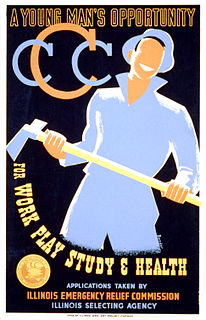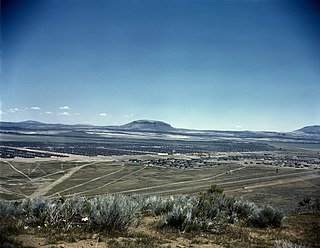| Camp Tule Lake | |
|---|---|
| Tule Lake, California | |
 | |
| Coordinates | 41°58′08″N121°34′05″W / 41.9688°N 121.5681°W Coordinates: 41°58′08″N121°34′05″W / 41.9688°N 121.5681°W |
| Type | Prisoner-of-war camp and Japanese American incarceration |
| Site information | |
| Owner | Fish and Wildlife Service |
| Condition | Restoration |
| Site history | |
| Built | 1933-1935 |
| Built by | Civilian Conservation Corps |
| In use | March 1943 - 25 April 1946 |
The Tule Lake camp was a federal work facility and WRA isolation center located in Siskiyou County, five miles west of Tulelake, California. It was established by the United States government in 1935 during the Great Depression for vocational training and work relief for young men, in a program known as the Civilian Conservation Corps. [1] The camp was established initially for CCC enrollees to work on the Klamath Reclamation Project.

Siskiyou County is a county in the northernmost part of the U.S. state of California. As of the 2010 census, the population was 44,900. Its county seat is Yreka and its highest point is Mount Shasta.

Tulelake is a city in Northeastern Siskiyou County, California, United States, at an elevation of 4,066 feet (1,239 m) above sea level. The town is named after nearby Tule Lake. The population was 1,010 at the 2010 census, down from 1,020 at the 2000 census. In an unusual circumstance, at least within California, Tulelake peace officers are authorized by state law, along with cooperation of the state of Oregon, to serve as and be recognized as peace officers within Malin, Oregon, along with the inverse being true for peace officers employed within Malin, wherein they are recognized as peace officers within Tulelake by the California Penal Code.

The Great Depression was a severe worldwide economic depression that took place mostly during the 1930s, beginning in the United States. The timing of the Great Depression varied across nations; in most countries it started in 1929 and lasted until the late-1930s. It was the longest, deepest, and most widespread depression of the 20th century. In the 21st century, the Great Depression is commonly used as an example of how intensely the world's economy can decline.
Contents
During World War II, in 1942 the Tule Lake War Relocation Center was built next to the camp as one of ten concentration camps in the interior of the US for the incarceration of Japanese Americans who had been forcibly relocated from the West Coast, which was defined as an Exclusion Zone by the US military. Two-thirds of the 120,000 incarcerated individuals were United States citizens.

World War II, also known as the Second World War, was a global war that lasted from 1939 to 1945. The vast majority of the world's countries—including all the great powers—eventually formed two opposing military alliances: the Allies and the Axis. A state of total war emerged, directly involving more than 100 million people from over 30 countries. The major participants threw their entire economic, industrial, and scientific capabilities behind the war effort, blurring the distinction between civilian and military resources. World War II was the deadliest conflict in human history, marked by 50 to 85 million fatalities, most of whom were civilians in the Soviet Union and China. It included massacres, the genocide of the Holocaust, strategic bombing, premeditated death from starvation and disease, and the only use of nuclear weapons in war.
Renamed the Tule Lake Isolation Center, this facility was adapted in the wartime years to shelter Japanese-American strikebreakers used against resisters at the main segregation camp, imprison Japanese-American dissidents, and house Italian and German prisoners of war (POWs) who were assigned to work as farm laborers in the region. [2] After the war, on 25 April 1946, the camp was transferred from the Army to the Fish and Wildlife Service, which had managed it just prior to the establishment of the segregation camp. [1] The four remaining buildings are being restored in a project to return the camp to its 1940s appearance.
















